Impact of Training and Development: Knowledge Exchange Project
VerifiedAdded on 2022/12/09
|29
|7005
|376
Project
AI Summary
This project investigates the impact of training and development on employee performance, focusing on the consultancy sector and using Deloitte as a case study. The research aims to assess the effects of training and development on employee performance within companies like Deloitte in the UK. The project explores the concept and significance of training and development, identifies various training methods, and examines the association between training and employee performance. The methodology includes a literature review, project planning, and data analysis. The findings highlight the importance of training programs in enhancing employee skills, productivity, and overall company performance. The project also recommends strategies for providing effective training and development to employees, ultimately benefiting both the organization and its workforce. The study emphasizes the need for continuous improvement and adaptation to meet the evolving demands of the business environment.

Knowledge Exchange Project
Paraphrase This Document
Need a fresh take? Get an instant paraphrase of this document with our AI Paraphraser
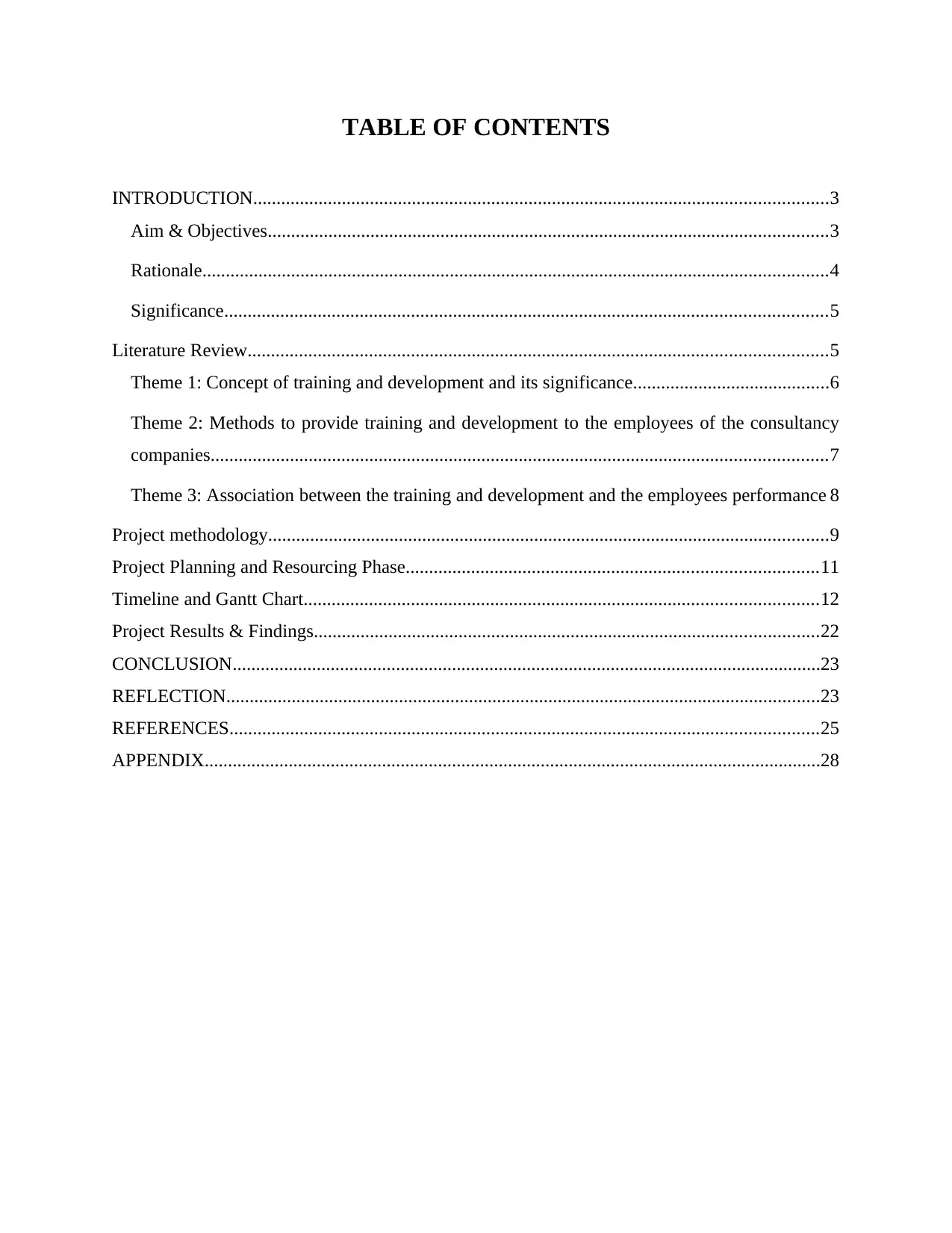
TABLE OF CONTENTS
INTRODUCTION...........................................................................................................................3
Aim & Objectives........................................................................................................................3
Rationale......................................................................................................................................4
Significance.................................................................................................................................5
Literature Review............................................................................................................................5
Theme 1: Concept of training and development and its significance..........................................6
Theme 2: Methods to provide training and development to the employees of the consultancy
companies....................................................................................................................................7
Theme 3: Association between the training and development and the employees performance 8
Project methodology........................................................................................................................9
Project Planning and Resourcing Phase........................................................................................11
Timeline and Gantt Chart..............................................................................................................12
Project Results & Findings............................................................................................................22
CONCLUSION..............................................................................................................................23
REFLECTION...............................................................................................................................23
REFERENCES..............................................................................................................................25
APPENDIX....................................................................................................................................28
INTRODUCTION...........................................................................................................................3
Aim & Objectives........................................................................................................................3
Rationale......................................................................................................................................4
Significance.................................................................................................................................5
Literature Review............................................................................................................................5
Theme 1: Concept of training and development and its significance..........................................6
Theme 2: Methods to provide training and development to the employees of the consultancy
companies....................................................................................................................................7
Theme 3: Association between the training and development and the employees performance 8
Project methodology........................................................................................................................9
Project Planning and Resourcing Phase........................................................................................11
Timeline and Gantt Chart..............................................................................................................12
Project Results & Findings............................................................................................................22
CONCLUSION..............................................................................................................................23
REFLECTION...............................................................................................................................23
REFERENCES..............................................................................................................................25
APPENDIX....................................................................................................................................28
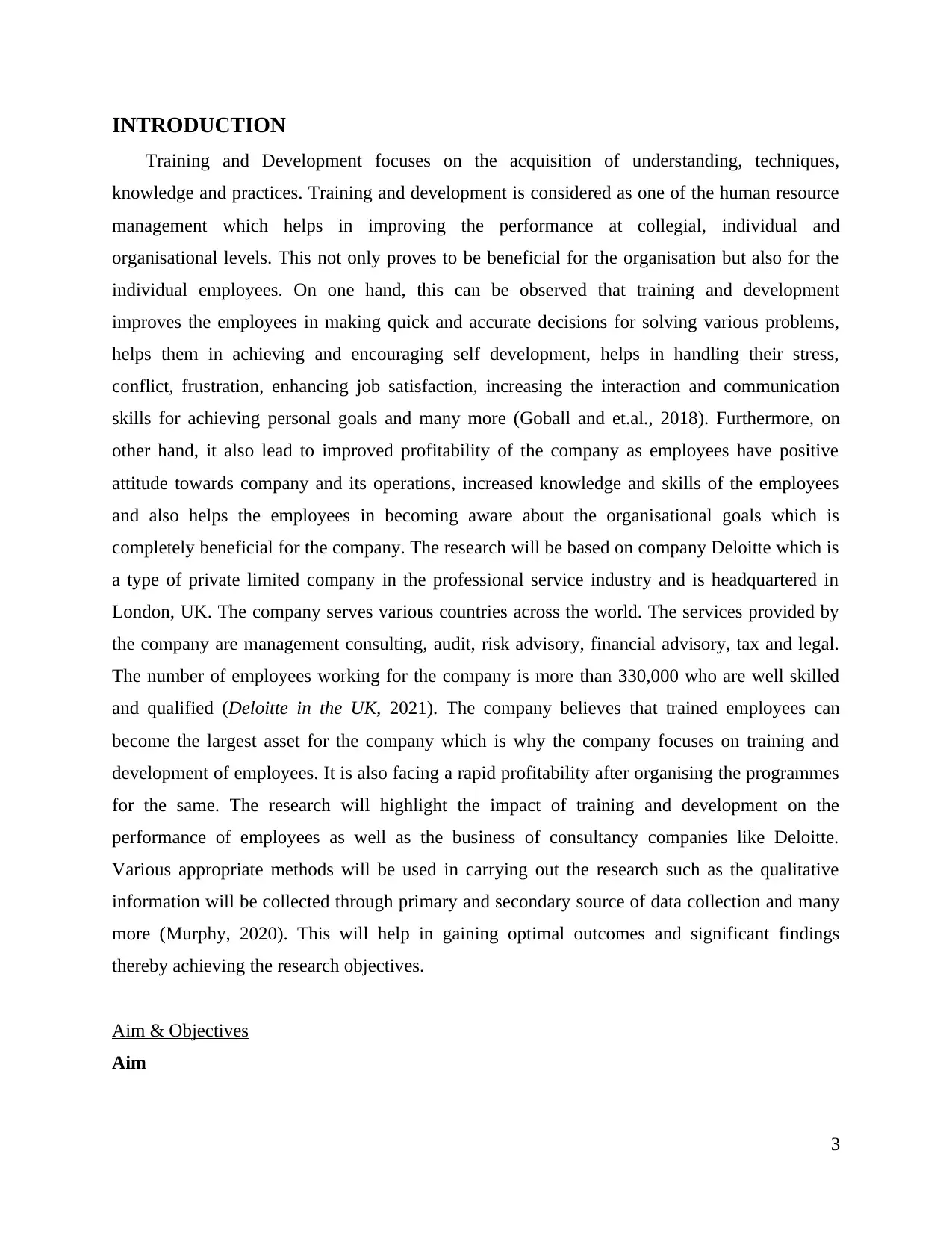
INTRODUCTION
Training and Development focuses on the acquisition of understanding, techniques,
knowledge and practices. Training and development is considered as one of the human resource
management which helps in improving the performance at collegial, individual and
organisational levels. This not only proves to be beneficial for the organisation but also for the
individual employees. On one hand, this can be observed that training and development
improves the employees in making quick and accurate decisions for solving various problems,
helps them in achieving and encouraging self development, helps in handling their stress,
conflict, frustration, enhancing job satisfaction, increasing the interaction and communication
skills for achieving personal goals and many more (Goball and et.al., 2018). Furthermore, on
other hand, it also lead to improved profitability of the company as employees have positive
attitude towards company and its operations, increased knowledge and skills of the employees
and also helps the employees in becoming aware about the organisational goals which is
completely beneficial for the company. The research will be based on company Deloitte which is
a type of private limited company in the professional service industry and is headquartered in
London, UK. The company serves various countries across the world. The services provided by
the company are management consulting, audit, risk advisory, financial advisory, tax and legal.
The number of employees working for the company is more than 330,000 who are well skilled
and qualified (Deloitte in the UK, 2021). The company believes that trained employees can
become the largest asset for the company which is why the company focuses on training and
development of employees. It is also facing a rapid profitability after organising the programmes
for the same. The research will highlight the impact of training and development on the
performance of employees as well as the business of consultancy companies like Deloitte.
Various appropriate methods will be used in carrying out the research such as the qualitative
information will be collected through primary and secondary source of data collection and many
more (Murphy, 2020). This will help in gaining optimal outcomes and significant findings
thereby achieving the research objectives.
Aim & Objectives
Aim
3
Training and Development focuses on the acquisition of understanding, techniques,
knowledge and practices. Training and development is considered as one of the human resource
management which helps in improving the performance at collegial, individual and
organisational levels. This not only proves to be beneficial for the organisation but also for the
individual employees. On one hand, this can be observed that training and development
improves the employees in making quick and accurate decisions for solving various problems,
helps them in achieving and encouraging self development, helps in handling their stress,
conflict, frustration, enhancing job satisfaction, increasing the interaction and communication
skills for achieving personal goals and many more (Goball and et.al., 2018). Furthermore, on
other hand, it also lead to improved profitability of the company as employees have positive
attitude towards company and its operations, increased knowledge and skills of the employees
and also helps the employees in becoming aware about the organisational goals which is
completely beneficial for the company. The research will be based on company Deloitte which is
a type of private limited company in the professional service industry and is headquartered in
London, UK. The company serves various countries across the world. The services provided by
the company are management consulting, audit, risk advisory, financial advisory, tax and legal.
The number of employees working for the company is more than 330,000 who are well skilled
and qualified (Deloitte in the UK, 2021). The company believes that trained employees can
become the largest asset for the company which is why the company focuses on training and
development of employees. It is also facing a rapid profitability after organising the programmes
for the same. The research will highlight the impact of training and development on the
performance of employees as well as the business of consultancy companies like Deloitte.
Various appropriate methods will be used in carrying out the research such as the qualitative
information will be collected through primary and secondary source of data collection and many
more (Murphy, 2020). This will help in gaining optimal outcomes and significant findings
thereby achieving the research objectives.
Aim & Objectives
Aim
3
⊘ This is a preview!⊘
Do you want full access?
Subscribe today to unlock all pages.

Trusted by 1+ million students worldwide
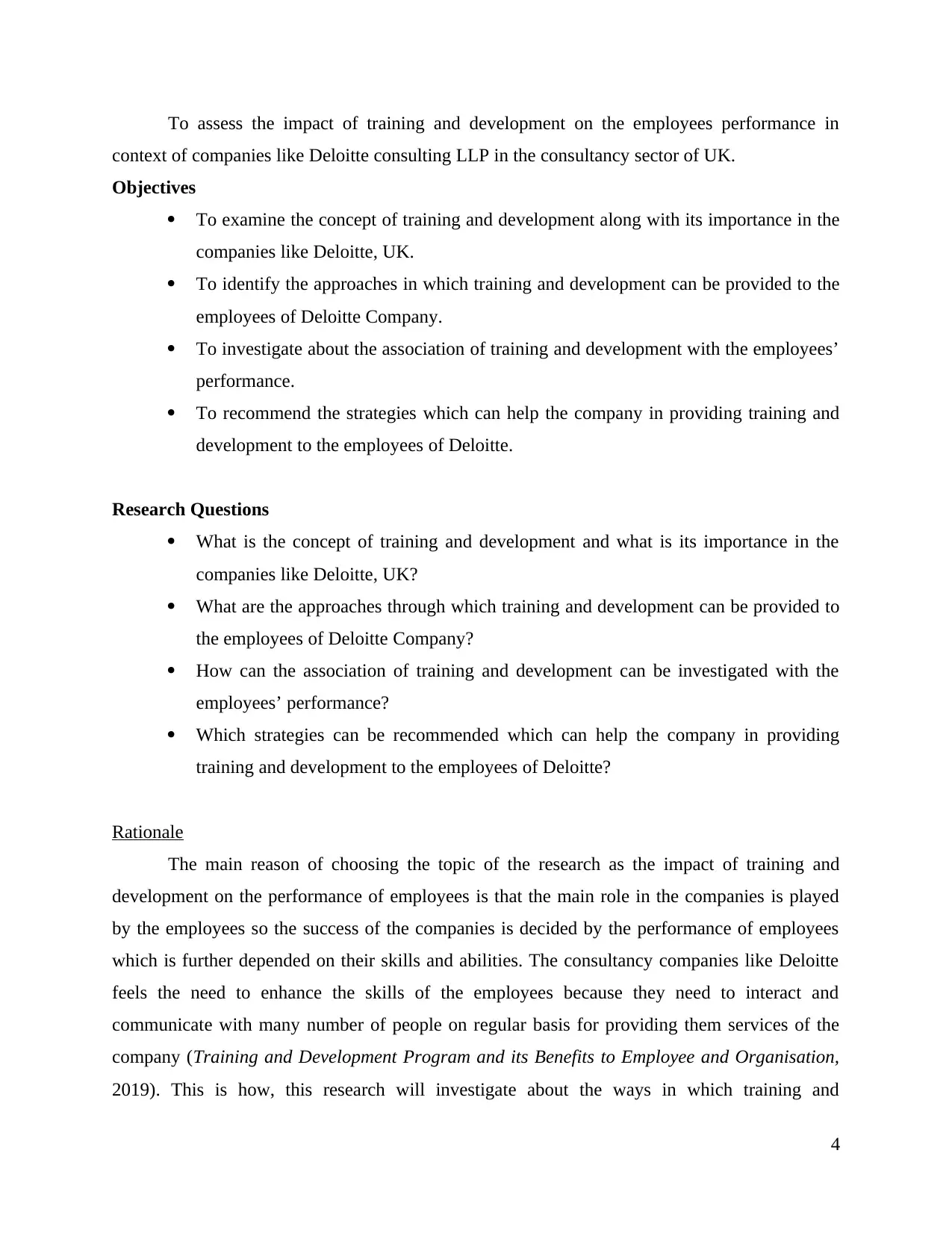
To assess the impact of training and development on the employees performance in
context of companies like Deloitte consulting LLP in the consultancy sector of UK.
Objectives
To examine the concept of training and development along with its importance in the
companies like Deloitte, UK.
To identify the approaches in which training and development can be provided to the
employees of Deloitte Company.
To investigate about the association of training and development with the employees’
performance.
To recommend the strategies which can help the company in providing training and
development to the employees of Deloitte.
Research Questions
What is the concept of training and development and what is its importance in the
companies like Deloitte, UK?
What are the approaches through which training and development can be provided to
the employees of Deloitte Company?
How can the association of training and development can be investigated with the
employees’ performance?
Which strategies can be recommended which can help the company in providing
training and development to the employees of Deloitte?
Rationale
The main reason of choosing the topic of the research as the impact of training and
development on the performance of employees is that the main role in the companies is played
by the employees so the success of the companies is decided by the performance of employees
which is further depended on their skills and abilities. The consultancy companies like Deloitte
feels the need to enhance the skills of the employees because they need to interact and
communicate with many number of people on regular basis for providing them services of the
company (Training and Development Program and its Benefits to Employee and Organisation,
2019). This is how, this research will investigate about the ways in which training and
4
context of companies like Deloitte consulting LLP in the consultancy sector of UK.
Objectives
To examine the concept of training and development along with its importance in the
companies like Deloitte, UK.
To identify the approaches in which training and development can be provided to the
employees of Deloitte Company.
To investigate about the association of training and development with the employees’
performance.
To recommend the strategies which can help the company in providing training and
development to the employees of Deloitte.
Research Questions
What is the concept of training and development and what is its importance in the
companies like Deloitte, UK?
What are the approaches through which training and development can be provided to
the employees of Deloitte Company?
How can the association of training and development can be investigated with the
employees’ performance?
Which strategies can be recommended which can help the company in providing
training and development to the employees of Deloitte?
Rationale
The main reason of choosing the topic of the research as the impact of training and
development on the performance of employees is that the main role in the companies is played
by the employees so the success of the companies is decided by the performance of employees
which is further depended on their skills and abilities. The consultancy companies like Deloitte
feels the need to enhance the skills of the employees because they need to interact and
communicate with many number of people on regular basis for providing them services of the
company (Training and Development Program and its Benefits to Employee and Organisation,
2019). This is how, this research will investigate about the ways in which training and
4
Paraphrase This Document
Need a fresh take? Get an instant paraphrase of this document with our AI Paraphraser
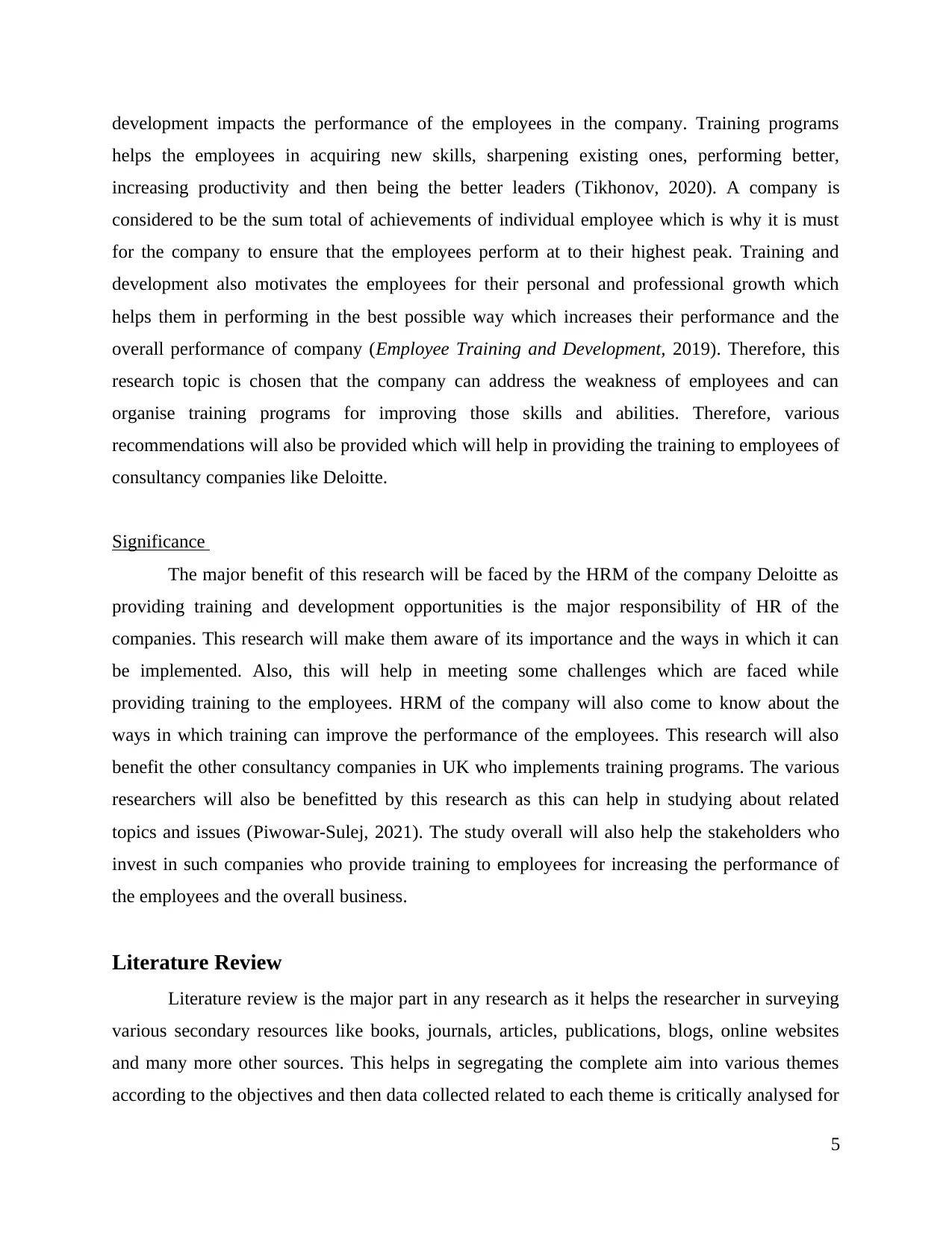
development impacts the performance of the employees in the company. Training programs
helps the employees in acquiring new skills, sharpening existing ones, performing better,
increasing productivity and then being the better leaders (Tikhonov, 2020). A company is
considered to be the sum total of achievements of individual employee which is why it is must
for the company to ensure that the employees perform at to their highest peak. Training and
development also motivates the employees for their personal and professional growth which
helps them in performing in the best possible way which increases their performance and the
overall performance of company (Employee Training and Development, 2019). Therefore, this
research topic is chosen that the company can address the weakness of employees and can
organise training programs for improving those skills and abilities. Therefore, various
recommendations will also be provided which will help in providing the training to employees of
consultancy companies like Deloitte.
Significance
The major benefit of this research will be faced by the HRM of the company Deloitte as
providing training and development opportunities is the major responsibility of HR of the
companies. This research will make them aware of its importance and the ways in which it can
be implemented. Also, this will help in meeting some challenges which are faced while
providing training to the employees. HRM of the company will also come to know about the
ways in which training can improve the performance of the employees. This research will also
benefit the other consultancy companies in UK who implements training programs. The various
researchers will also be benefitted by this research as this can help in studying about related
topics and issues (Piwowar-Sulej, 2021). The study overall will also help the stakeholders who
invest in such companies who provide training to employees for increasing the performance of
the employees and the overall business.
Literature Review
Literature review is the major part in any research as it helps the researcher in surveying
various secondary resources like books, journals, articles, publications, blogs, online websites
and many more other sources. This helps in segregating the complete aim into various themes
according to the objectives and then data collected related to each theme is critically analysed for
5
helps the employees in acquiring new skills, sharpening existing ones, performing better,
increasing productivity and then being the better leaders (Tikhonov, 2020). A company is
considered to be the sum total of achievements of individual employee which is why it is must
for the company to ensure that the employees perform at to their highest peak. Training and
development also motivates the employees for their personal and professional growth which
helps them in performing in the best possible way which increases their performance and the
overall performance of company (Employee Training and Development, 2019). Therefore, this
research topic is chosen that the company can address the weakness of employees and can
organise training programs for improving those skills and abilities. Therefore, various
recommendations will also be provided which will help in providing the training to employees of
consultancy companies like Deloitte.
Significance
The major benefit of this research will be faced by the HRM of the company Deloitte as
providing training and development opportunities is the major responsibility of HR of the
companies. This research will make them aware of its importance and the ways in which it can
be implemented. Also, this will help in meeting some challenges which are faced while
providing training to the employees. HRM of the company will also come to know about the
ways in which training can improve the performance of the employees. This research will also
benefit the other consultancy companies in UK who implements training programs. The various
researchers will also be benefitted by this research as this can help in studying about related
topics and issues (Piwowar-Sulej, 2021). The study overall will also help the stakeholders who
invest in such companies who provide training to employees for increasing the performance of
the employees and the overall business.
Literature Review
Literature review is the major part in any research as it helps the researcher in surveying
various secondary resources like books, journals, articles, publications, blogs, online websites
and many more other sources. This helps in segregating the complete aim into various themes
according to the objectives and then data collected related to each theme is critically analysed for
5
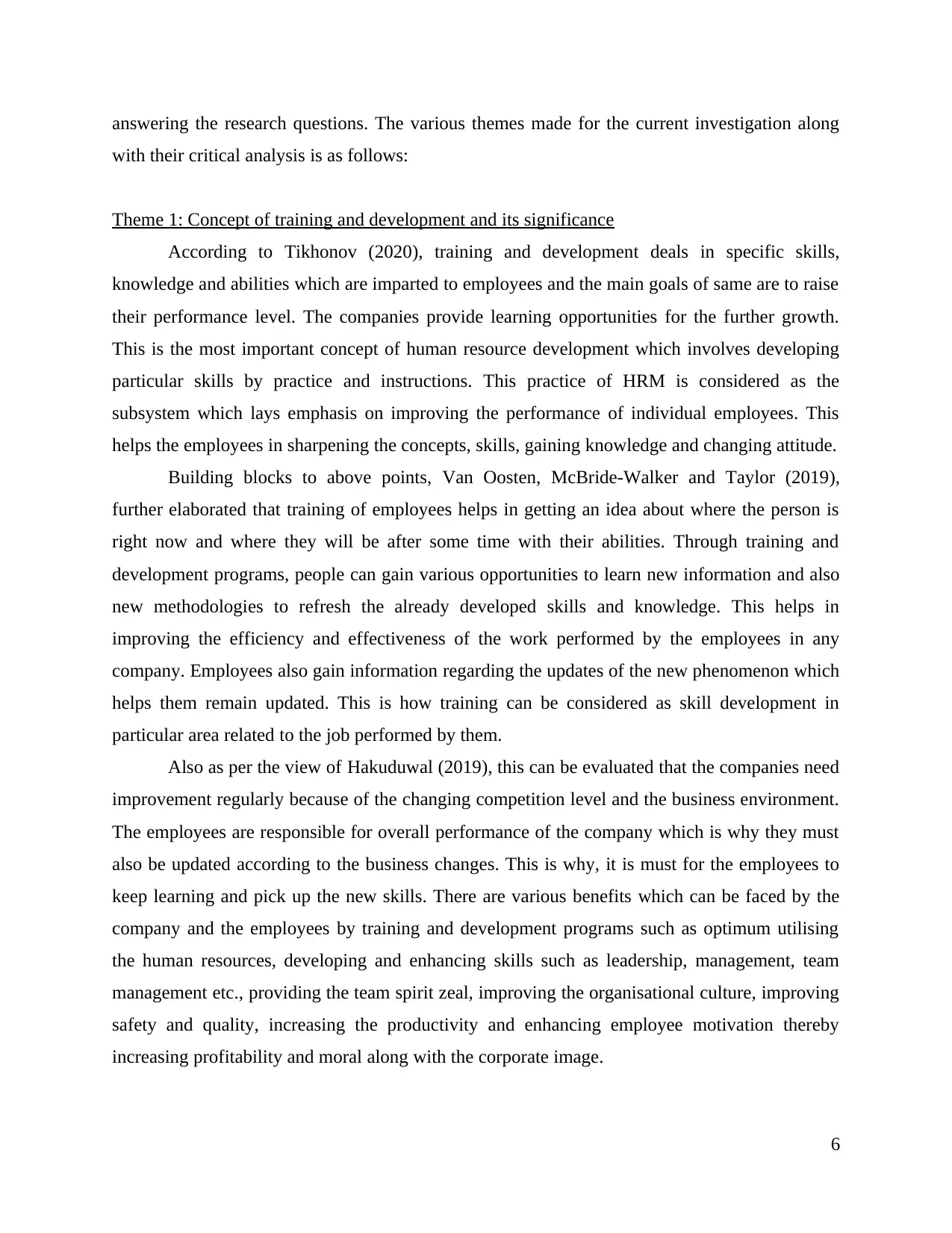
answering the research questions. The various themes made for the current investigation along
with their critical analysis is as follows:
Theme 1: Concept of training and development and its significance
According to Tikhonov (2020), training and development deals in specific skills,
knowledge and abilities which are imparted to employees and the main goals of same are to raise
their performance level. The companies provide learning opportunities for the further growth.
This is the most important concept of human resource development which involves developing
particular skills by practice and instructions. This practice of HRM is considered as the
subsystem which lays emphasis on improving the performance of individual employees. This
helps the employees in sharpening the concepts, skills, gaining knowledge and changing attitude.
Building blocks to above points, Van Oosten, McBride-Walker and Taylor (2019),
further elaborated that training of employees helps in getting an idea about where the person is
right now and where they will be after some time with their abilities. Through training and
development programs, people can gain various opportunities to learn new information and also
new methodologies to refresh the already developed skills and knowledge. This helps in
improving the efficiency and effectiveness of the work performed by the employees in any
company. Employees also gain information regarding the updates of the new phenomenon which
helps them remain updated. This is how training can be considered as skill development in
particular area related to the job performed by them.
Also as per the view of Hakuduwal (2019), this can be evaluated that the companies need
improvement regularly because of the changing competition level and the business environment.
The employees are responsible for overall performance of the company which is why they must
also be updated according to the business changes. This is why, it is must for the employees to
keep learning and pick up the new skills. There are various benefits which can be faced by the
company and the employees by training and development programs such as optimum utilising
the human resources, developing and enhancing skills such as leadership, management, team
management etc., providing the team spirit zeal, improving the organisational culture, improving
safety and quality, increasing the productivity and enhancing employee motivation thereby
increasing profitability and moral along with the corporate image.
6
with their critical analysis is as follows:
Theme 1: Concept of training and development and its significance
According to Tikhonov (2020), training and development deals in specific skills,
knowledge and abilities which are imparted to employees and the main goals of same are to raise
their performance level. The companies provide learning opportunities for the further growth.
This is the most important concept of human resource development which involves developing
particular skills by practice and instructions. This practice of HRM is considered as the
subsystem which lays emphasis on improving the performance of individual employees. This
helps the employees in sharpening the concepts, skills, gaining knowledge and changing attitude.
Building blocks to above points, Van Oosten, McBride-Walker and Taylor (2019),
further elaborated that training of employees helps in getting an idea about where the person is
right now and where they will be after some time with their abilities. Through training and
development programs, people can gain various opportunities to learn new information and also
new methodologies to refresh the already developed skills and knowledge. This helps in
improving the efficiency and effectiveness of the work performed by the employees in any
company. Employees also gain information regarding the updates of the new phenomenon which
helps them remain updated. This is how training can be considered as skill development in
particular area related to the job performed by them.
Also as per the view of Hakuduwal (2019), this can be evaluated that the companies need
improvement regularly because of the changing competition level and the business environment.
The employees are responsible for overall performance of the company which is why they must
also be updated according to the business changes. This is why, it is must for the employees to
keep learning and pick up the new skills. There are various benefits which can be faced by the
company and the employees by training and development programs such as optimum utilising
the human resources, developing and enhancing skills such as leadership, management, team
management etc., providing the team spirit zeal, improving the organisational culture, improving
safety and quality, increasing the productivity and enhancing employee motivation thereby
increasing profitability and moral along with the corporate image.
6
⊘ This is a preview!⊘
Do you want full access?
Subscribe today to unlock all pages.

Trusted by 1+ million students worldwide
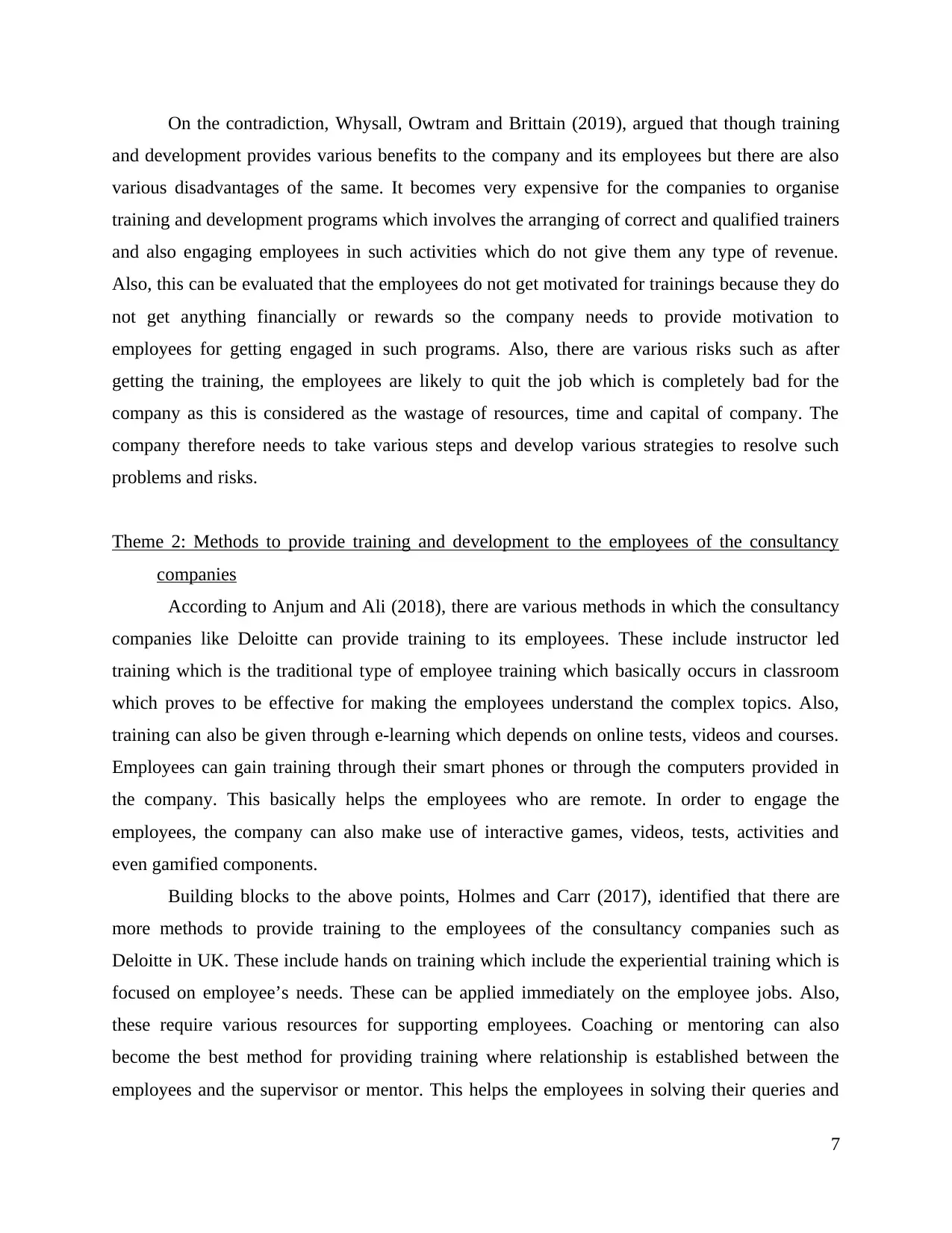
On the contradiction, Whysall, Owtram and Brittain (2019), argued that though training
and development provides various benefits to the company and its employees but there are also
various disadvantages of the same. It becomes very expensive for the companies to organise
training and development programs which involves the arranging of correct and qualified trainers
and also engaging employees in such activities which do not give them any type of revenue.
Also, this can be evaluated that the employees do not get motivated for trainings because they do
not get anything financially or rewards so the company needs to provide motivation to
employees for getting engaged in such programs. Also, there are various risks such as after
getting the training, the employees are likely to quit the job which is completely bad for the
company as this is considered as the wastage of resources, time and capital of company. The
company therefore needs to take various steps and develop various strategies to resolve such
problems and risks.
Theme 2: Methods to provide training and development to the employees of the consultancy
companies
According to Anjum and Ali (2018), there are various methods in which the consultancy
companies like Deloitte can provide training to its employees. These include instructor led
training which is the traditional type of employee training which basically occurs in classroom
which proves to be effective for making the employees understand the complex topics. Also,
training can also be given through e-learning which depends on online tests, videos and courses.
Employees can gain training through their smart phones or through the computers provided in
the company. This basically helps the employees who are remote. In order to engage the
employees, the company can also make use of interactive games, videos, tests, activities and
even gamified components.
Building blocks to the above points, Holmes and Carr (2017), identified that there are
more methods to provide training to the employees of the consultancy companies such as
Deloitte in UK. These include hands on training which include the experiential training which is
focused on employee’s needs. These can be applied immediately on the employee jobs. Also,
these require various resources for supporting employees. Coaching or mentoring can also
become the best method for providing training where relationship is established between the
employees and the supervisor or mentor. This helps the employees in solving their queries and
7
and development provides various benefits to the company and its employees but there are also
various disadvantages of the same. It becomes very expensive for the companies to organise
training and development programs which involves the arranging of correct and qualified trainers
and also engaging employees in such activities which do not give them any type of revenue.
Also, this can be evaluated that the employees do not get motivated for trainings because they do
not get anything financially or rewards so the company needs to provide motivation to
employees for getting engaged in such programs. Also, there are various risks such as after
getting the training, the employees are likely to quit the job which is completely bad for the
company as this is considered as the wastage of resources, time and capital of company. The
company therefore needs to take various steps and develop various strategies to resolve such
problems and risks.
Theme 2: Methods to provide training and development to the employees of the consultancy
companies
According to Anjum and Ali (2018), there are various methods in which the consultancy
companies like Deloitte can provide training to its employees. These include instructor led
training which is the traditional type of employee training which basically occurs in classroom
which proves to be effective for making the employees understand the complex topics. Also,
training can also be given through e-learning which depends on online tests, videos and courses.
Employees can gain training through their smart phones or through the computers provided in
the company. This basically helps the employees who are remote. In order to engage the
employees, the company can also make use of interactive games, videos, tests, activities and
even gamified components.
Building blocks to the above points, Holmes and Carr (2017), identified that there are
more methods to provide training to the employees of the consultancy companies such as
Deloitte in UK. These include hands on training which include the experiential training which is
focused on employee’s needs. These can be applied immediately on the employee jobs. Also,
these require various resources for supporting employees. Coaching or mentoring can also
become the best method for providing training where relationship is established between the
employees and the supervisor or mentor. This helps the employees in solving their queries and
7
Paraphrase This Document
Need a fresh take? Get an instant paraphrase of this document with our AI Paraphraser
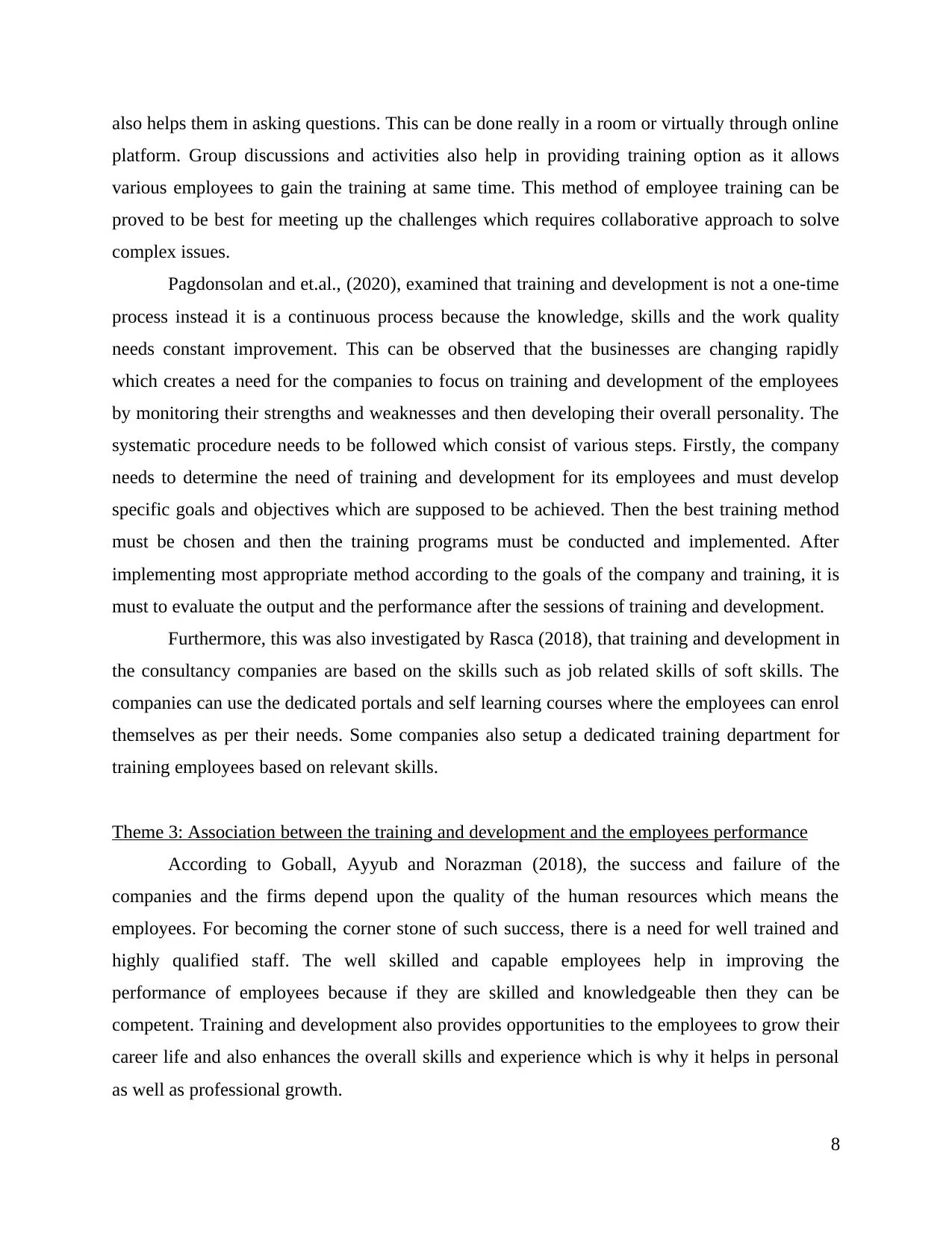
also helps them in asking questions. This can be done really in a room or virtually through online
platform. Group discussions and activities also help in providing training option as it allows
various employees to gain the training at same time. This method of employee training can be
proved to be best for meeting up the challenges which requires collaborative approach to solve
complex issues.
Pagdonsolan and et.al., (2020), examined that training and development is not a one-time
process instead it is a continuous process because the knowledge, skills and the work quality
needs constant improvement. This can be observed that the businesses are changing rapidly
which creates a need for the companies to focus on training and development of the employees
by monitoring their strengths and weaknesses and then developing their overall personality. The
systematic procedure needs to be followed which consist of various steps. Firstly, the company
needs to determine the need of training and development for its employees and must develop
specific goals and objectives which are supposed to be achieved. Then the best training method
must be chosen and then the training programs must be conducted and implemented. After
implementing most appropriate method according to the goals of the company and training, it is
must to evaluate the output and the performance after the sessions of training and development.
Furthermore, this was also investigated by Rasca (2018), that training and development in
the consultancy companies are based on the skills such as job related skills of soft skills. The
companies can use the dedicated portals and self learning courses where the employees can enrol
themselves as per their needs. Some companies also setup a dedicated training department for
training employees based on relevant skills.
Theme 3: Association between the training and development and the employees performance
According to Goball, Ayyub and Norazman (2018), the success and failure of the
companies and the firms depend upon the quality of the human resources which means the
employees. For becoming the corner stone of such success, there is a need for well trained and
highly qualified staff. The well skilled and capable employees help in improving the
performance of employees because if they are skilled and knowledgeable then they can be
competent. Training and development also provides opportunities to the employees to grow their
career life and also enhances the overall skills and experience which is why it helps in personal
as well as professional growth.
8
platform. Group discussions and activities also help in providing training option as it allows
various employees to gain the training at same time. This method of employee training can be
proved to be best for meeting up the challenges which requires collaborative approach to solve
complex issues.
Pagdonsolan and et.al., (2020), examined that training and development is not a one-time
process instead it is a continuous process because the knowledge, skills and the work quality
needs constant improvement. This can be observed that the businesses are changing rapidly
which creates a need for the companies to focus on training and development of the employees
by monitoring their strengths and weaknesses and then developing their overall personality. The
systematic procedure needs to be followed which consist of various steps. Firstly, the company
needs to determine the need of training and development for its employees and must develop
specific goals and objectives which are supposed to be achieved. Then the best training method
must be chosen and then the training programs must be conducted and implemented. After
implementing most appropriate method according to the goals of the company and training, it is
must to evaluate the output and the performance after the sessions of training and development.
Furthermore, this was also investigated by Rasca (2018), that training and development in
the consultancy companies are based on the skills such as job related skills of soft skills. The
companies can use the dedicated portals and self learning courses where the employees can enrol
themselves as per their needs. Some companies also setup a dedicated training department for
training employees based on relevant skills.
Theme 3: Association between the training and development and the employees performance
According to Goball, Ayyub and Norazman (2018), the success and failure of the
companies and the firms depend upon the quality of the human resources which means the
employees. For becoming the corner stone of such success, there is a need for well trained and
highly qualified staff. The well skilled and capable employees help in improving the
performance of employees because if they are skilled and knowledgeable then they can be
competent. Training and development also provides opportunities to the employees to grow their
career life and also enhances the overall skills and experience which is why it helps in personal
as well as professional growth.
8
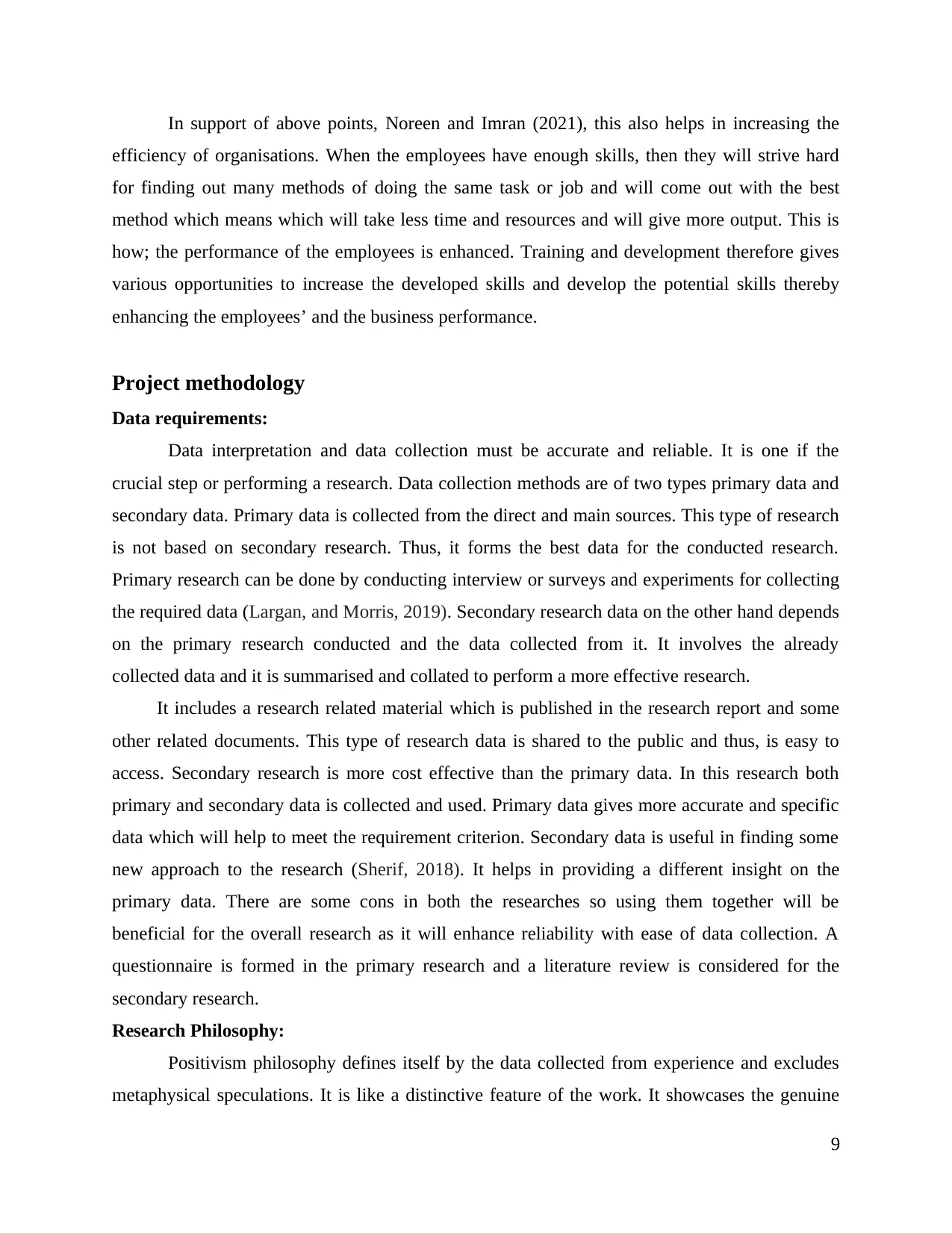
In support of above points, Noreen and Imran (2021), this also helps in increasing the
efficiency of organisations. When the employees have enough skills, then they will strive hard
for finding out many methods of doing the same task or job and will come out with the best
method which means which will take less time and resources and will give more output. This is
how; the performance of the employees is enhanced. Training and development therefore gives
various opportunities to increase the developed skills and develop the potential skills thereby
enhancing the employees’ and the business performance.
Project methodology
Data requirements:
Data interpretation and data collection must be accurate and reliable. It is one if the
crucial step or performing a research. Data collection methods are of two types primary data and
secondary data. Primary data is collected from the direct and main sources. This type of research
is not based on secondary research. Thus, it forms the best data for the conducted research.
Primary research can be done by conducting interview or surveys and experiments for collecting
the required data (Largan, and Morris, 2019). Secondary research data on the other hand depends
on the primary research conducted and the data collected from it. It involves the already
collected data and it is summarised and collated to perform a more effective research.
It includes a research related material which is published in the research report and some
other related documents. This type of research data is shared to the public and thus, is easy to
access. Secondary research is more cost effective than the primary data. In this research both
primary and secondary data is collected and used. Primary data gives more accurate and specific
data which will help to meet the requirement criterion. Secondary data is useful in finding some
new approach to the research (Sherif, 2018). It helps in providing a different insight on the
primary data. There are some cons in both the researches so using them together will be
beneficial for the overall research as it will enhance reliability with ease of data collection. A
questionnaire is formed in the primary research and a literature review is considered for the
secondary research.
Research Philosophy:
Positivism philosophy defines itself by the data collected from experience and excludes
metaphysical speculations. It is like a distinctive feature of the work. It showcases the genuine
9
efficiency of organisations. When the employees have enough skills, then they will strive hard
for finding out many methods of doing the same task or job and will come out with the best
method which means which will take less time and resources and will give more output. This is
how; the performance of the employees is enhanced. Training and development therefore gives
various opportunities to increase the developed skills and develop the potential skills thereby
enhancing the employees’ and the business performance.
Project methodology
Data requirements:
Data interpretation and data collection must be accurate and reliable. It is one if the
crucial step or performing a research. Data collection methods are of two types primary data and
secondary data. Primary data is collected from the direct and main sources. This type of research
is not based on secondary research. Thus, it forms the best data for the conducted research.
Primary research can be done by conducting interview or surveys and experiments for collecting
the required data (Largan, and Morris, 2019). Secondary research data on the other hand depends
on the primary research conducted and the data collected from it. It involves the already
collected data and it is summarised and collated to perform a more effective research.
It includes a research related material which is published in the research report and some
other related documents. This type of research data is shared to the public and thus, is easy to
access. Secondary research is more cost effective than the primary data. In this research both
primary and secondary data is collected and used. Primary data gives more accurate and specific
data which will help to meet the requirement criterion. Secondary data is useful in finding some
new approach to the research (Sherif, 2018). It helps in providing a different insight on the
primary data. There are some cons in both the researches so using them together will be
beneficial for the overall research as it will enhance reliability with ease of data collection. A
questionnaire is formed in the primary research and a literature review is considered for the
secondary research.
Research Philosophy:
Positivism philosophy defines itself by the data collected from experience and excludes
metaphysical speculations. It is like a distinctive feature of the work. It showcases the genuine
9
⊘ This is a preview!⊘
Do you want full access?
Subscribe today to unlock all pages.

Trusted by 1+ million students worldwide
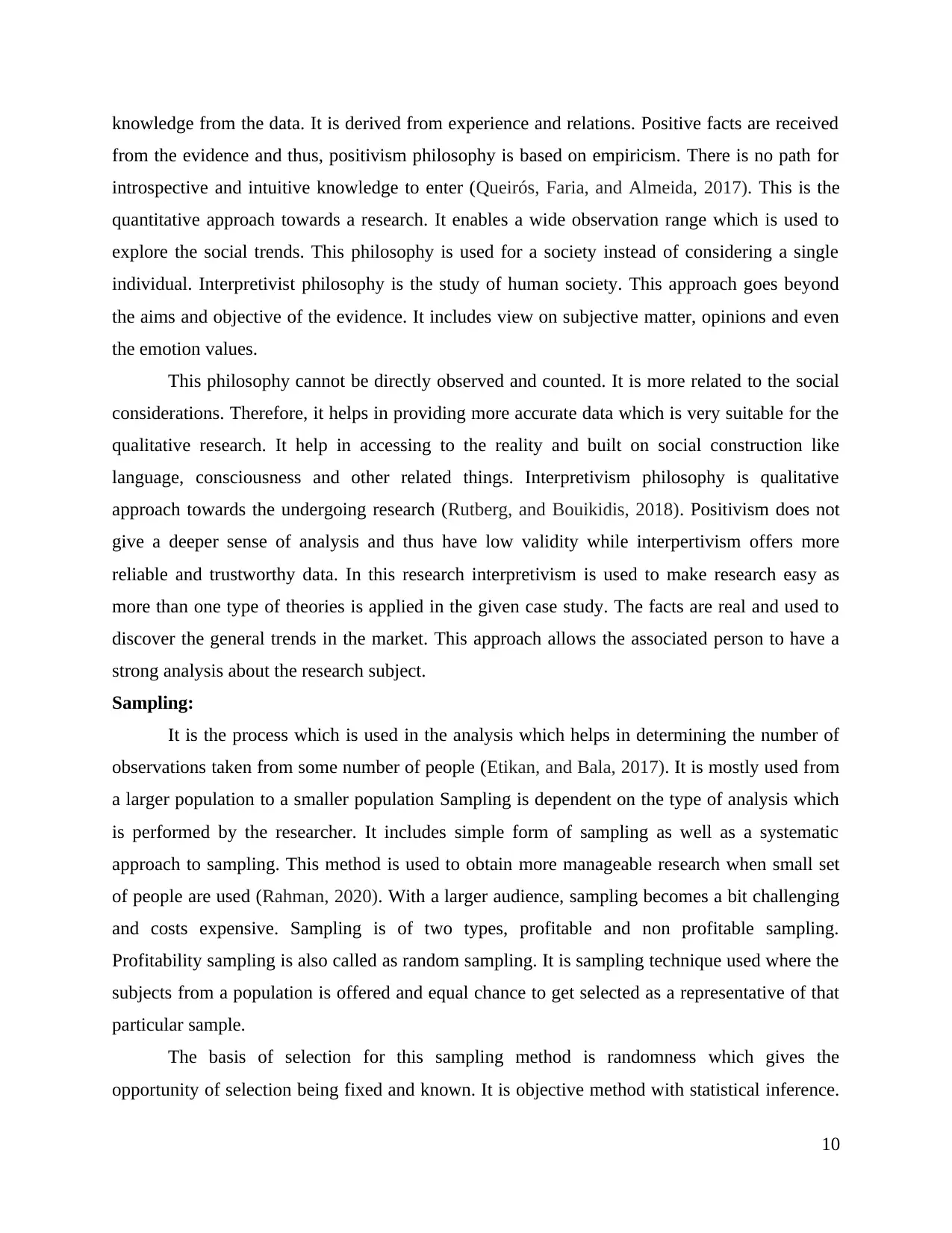
knowledge from the data. It is derived from experience and relations. Positive facts are received
from the evidence and thus, positivism philosophy is based on empiricism. There is no path for
introspective and intuitive knowledge to enter (Queirós, Faria, and Almeida, 2017). This is the
quantitative approach towards a research. It enables a wide observation range which is used to
explore the social trends. This philosophy is used for a society instead of considering a single
individual. Interpretivist philosophy is the study of human society. This approach goes beyond
the aims and objective of the evidence. It includes view on subjective matter, opinions and even
the emotion values.
This philosophy cannot be directly observed and counted. It is more related to the social
considerations. Therefore, it helps in providing more accurate data which is very suitable for the
qualitative research. It help in accessing to the reality and built on social construction like
language, consciousness and other related things. Interpretivism philosophy is qualitative
approach towards the undergoing research (Rutberg, and Bouikidis, 2018). Positivism does not
give a deeper sense of analysis and thus have low validity while interpertivism offers more
reliable and trustworthy data. In this research interpretivism is used to make research easy as
more than one type of theories is applied in the given case study. The facts are real and used to
discover the general trends in the market. This approach allows the associated person to have a
strong analysis about the research subject.
Sampling:
It is the process which is used in the analysis which helps in determining the number of
observations taken from some number of people (Etikan, and Bala, 2017). It is mostly used from
a larger population to a smaller population Sampling is dependent on the type of analysis which
is performed by the researcher. It includes simple form of sampling as well as a systematic
approach to sampling. This method is used to obtain more manageable research when small set
of people are used (Rahman, 2020). With a larger audience, sampling becomes a bit challenging
and costs expensive. Sampling is of two types, profitable and non profitable sampling.
Profitability sampling is also called as random sampling. It is sampling technique used where the
subjects from a population is offered and equal chance to get selected as a representative of that
particular sample.
The basis of selection for this sampling method is randomness which gives the
opportunity of selection being fixed and known. It is objective method with statistical inference.
10
from the evidence and thus, positivism philosophy is based on empiricism. There is no path for
introspective and intuitive knowledge to enter (Queirós, Faria, and Almeida, 2017). This is the
quantitative approach towards a research. It enables a wide observation range which is used to
explore the social trends. This philosophy is used for a society instead of considering a single
individual. Interpretivist philosophy is the study of human society. This approach goes beyond
the aims and objective of the evidence. It includes view on subjective matter, opinions and even
the emotion values.
This philosophy cannot be directly observed and counted. It is more related to the social
considerations. Therefore, it helps in providing more accurate data which is very suitable for the
qualitative research. It help in accessing to the reality and built on social construction like
language, consciousness and other related things. Interpretivism philosophy is qualitative
approach towards the undergoing research (Rutberg, and Bouikidis, 2018). Positivism does not
give a deeper sense of analysis and thus have low validity while interpertivism offers more
reliable and trustworthy data. In this research interpretivism is used to make research easy as
more than one type of theories is applied in the given case study. The facts are real and used to
discover the general trends in the market. This approach allows the associated person to have a
strong analysis about the research subject.
Sampling:
It is the process which is used in the analysis which helps in determining the number of
observations taken from some number of people (Etikan, and Bala, 2017). It is mostly used from
a larger population to a smaller population Sampling is dependent on the type of analysis which
is performed by the researcher. It includes simple form of sampling as well as a systematic
approach to sampling. This method is used to obtain more manageable research when small set
of people are used (Rahman, 2020). With a larger audience, sampling becomes a bit challenging
and costs expensive. Sampling is of two types, profitable and non profitable sampling.
Profitability sampling is also called as random sampling. It is sampling technique used where the
subjects from a population is offered and equal chance to get selected as a representative of that
particular sample.
The basis of selection for this sampling method is randomness which gives the
opportunity of selection being fixed and known. It is objective method with statistical inference.
10
Paraphrase This Document
Need a fresh take? Get an instant paraphrase of this document with our AI Paraphraser
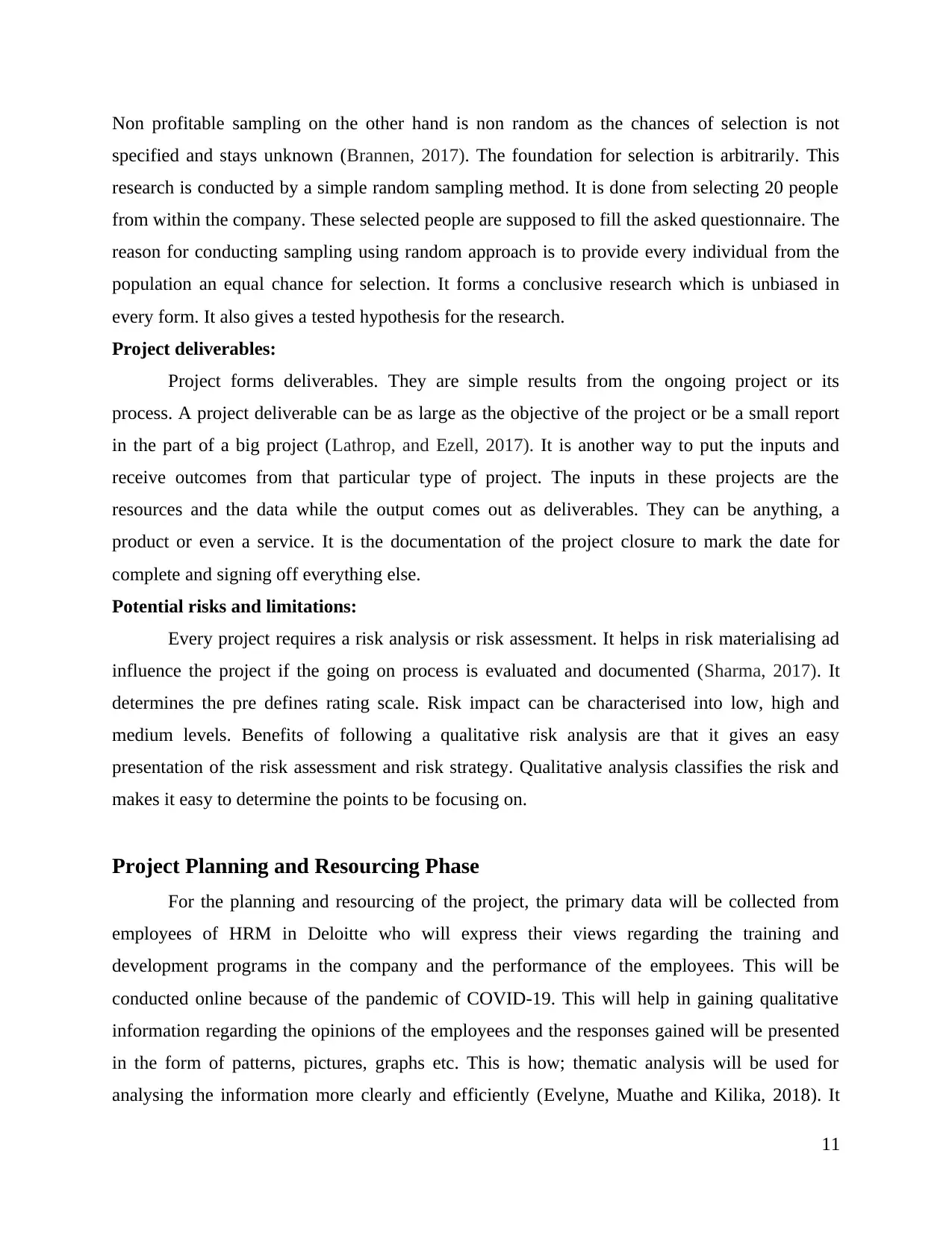
Non profitable sampling on the other hand is non random as the chances of selection is not
specified and stays unknown (Brannen, 2017). The foundation for selection is arbitrarily. This
research is conducted by a simple random sampling method. It is done from selecting 20 people
from within the company. These selected people are supposed to fill the asked questionnaire. The
reason for conducting sampling using random approach is to provide every individual from the
population an equal chance for selection. It forms a conclusive research which is unbiased in
every form. It also gives a tested hypothesis for the research.
Project deliverables:
Project forms deliverables. They are simple results from the ongoing project or its
process. A project deliverable can be as large as the objective of the project or be a small report
in the part of a big project (Lathrop, and Ezell, 2017). It is another way to put the inputs and
receive outcomes from that particular type of project. The inputs in these projects are the
resources and the data while the output comes out as deliverables. They can be anything, a
product or even a service. It is the documentation of the project closure to mark the date for
complete and signing off everything else.
Potential risks and limitations:
Every project requires a risk analysis or risk assessment. It helps in risk materialising ad
influence the project if the going on process is evaluated and documented (Sharma, 2017). It
determines the pre defines rating scale. Risk impact can be characterised into low, high and
medium levels. Benefits of following a qualitative risk analysis are that it gives an easy
presentation of the risk assessment and risk strategy. Qualitative analysis classifies the risk and
makes it easy to determine the points to be focusing on.
Project Planning and Resourcing Phase
For the planning and resourcing of the project, the primary data will be collected from
employees of HRM in Deloitte who will express their views regarding the training and
development programs in the company and the performance of the employees. This will be
conducted online because of the pandemic of COVID-19. This will help in gaining qualitative
information regarding the opinions of the employees and the responses gained will be presented
in the form of patterns, pictures, graphs etc. This is how; thematic analysis will be used for
analysing the information more clearly and efficiently (Evelyne, Muathe and Kilika, 2018). It
11
specified and stays unknown (Brannen, 2017). The foundation for selection is arbitrarily. This
research is conducted by a simple random sampling method. It is done from selecting 20 people
from within the company. These selected people are supposed to fill the asked questionnaire. The
reason for conducting sampling using random approach is to provide every individual from the
population an equal chance for selection. It forms a conclusive research which is unbiased in
every form. It also gives a tested hypothesis for the research.
Project deliverables:
Project forms deliverables. They are simple results from the ongoing project or its
process. A project deliverable can be as large as the objective of the project or be a small report
in the part of a big project (Lathrop, and Ezell, 2017). It is another way to put the inputs and
receive outcomes from that particular type of project. The inputs in these projects are the
resources and the data while the output comes out as deliverables. They can be anything, a
product or even a service. It is the documentation of the project closure to mark the date for
complete and signing off everything else.
Potential risks and limitations:
Every project requires a risk analysis or risk assessment. It helps in risk materialising ad
influence the project if the going on process is evaluated and documented (Sharma, 2017). It
determines the pre defines rating scale. Risk impact can be characterised into low, high and
medium levels. Benefits of following a qualitative risk analysis are that it gives an easy
presentation of the risk assessment and risk strategy. Qualitative analysis classifies the risk and
makes it easy to determine the points to be focusing on.
Project Planning and Resourcing Phase
For the planning and resourcing of the project, the primary data will be collected from
employees of HRM in Deloitte who will express their views regarding the training and
development programs in the company and the performance of the employees. This will be
conducted online because of the pandemic of COVID-19. This will help in gaining qualitative
information regarding the opinions of the employees and the responses gained will be presented
in the form of patterns, pictures, graphs etc. This is how; thematic analysis will be used for
analysing the information more clearly and efficiently (Evelyne, Muathe and Kilika, 2018). It
11
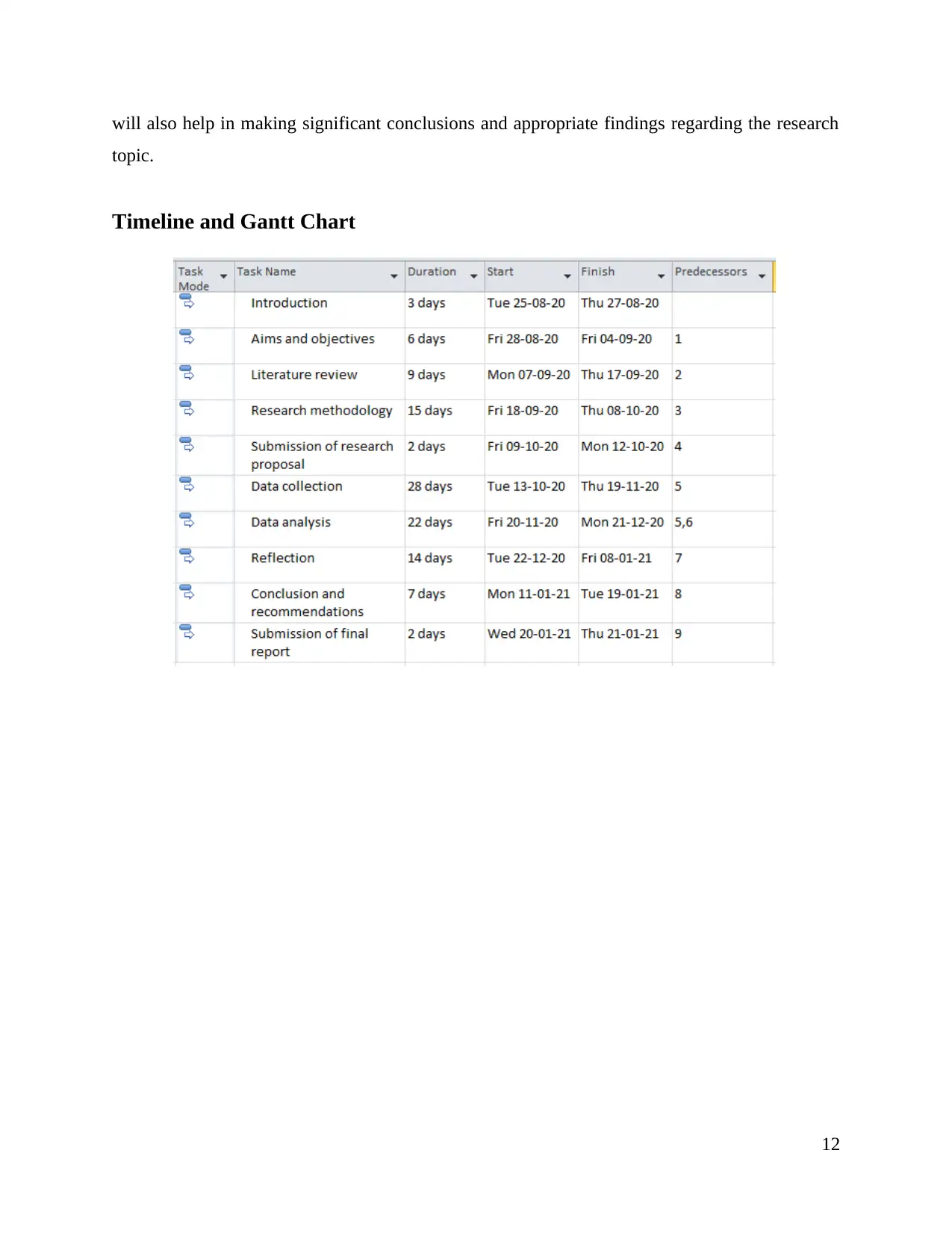
will also help in making significant conclusions and appropriate findings regarding the research
topic.
Timeline and Gantt Chart
12
topic.
Timeline and Gantt Chart
12
⊘ This is a preview!⊘
Do you want full access?
Subscribe today to unlock all pages.

Trusted by 1+ million students worldwide
1 out of 29
Related Documents
Your All-in-One AI-Powered Toolkit for Academic Success.
+13062052269
info@desklib.com
Available 24*7 on WhatsApp / Email
![[object Object]](/_next/static/media/star-bottom.7253800d.svg)
Unlock your academic potential
Copyright © 2020–2025 A2Z Services. All Rights Reserved. Developed and managed by ZUCOL.




